QuestionQUESTION: I have a 7 year old pit-lab mix. We've had him for a while (obviously) and he's always been good about not chewing on things in the house. However, he has a fear of being locked up (he refuses to be, will snarl, snap, grawl and everything imaginable). Thats not my concern. Just recently (after a year and a half) he has been clawing at, even destroying one of our roommates door for the past month. He has done it 4 times now (each time, after we all have left.) At first I thought it was separation anxiety, then boredom...but its only that door!! I've gone in there, and haven't found anything that shouldn't be in there, and I just don't understand why he'd start doing this now, after so long...and only to that one door...what should I do? Being that it's not the only door in the house that is shut...it just doesn't make any since to me. What could it be? Do you think theres a possibility that it could be Complex Partial Seizures ?
please email me back
stephanie_stefern@Yahoo.com
ANSWER: Hi Stephanie,
Your dog's problem doesn't sound as all like any kind of seizure to me. If you'd like possibility of seizures ruled out, a visit to your veterinarian would put your concerns to rest.
In your message you refer to your dog's chewing problem as "just recently", but then you describe the "recent" history as being a year and a half. If your dog has established this behavior, and it's going on for a year and a half, that's not "recent", it's persistent.
It's also quite a habit by now, making it even more difficult to stop the behavior.
If your dog chewing things up only when he's left alone, then I'd be inclined to think it's separation anxiety or boredom as you mentioned.
You haven't mentioned what you've tried to resolve this issue, but have you tried treating this like a separation anxiety or boredom problem?
You also didn't say how long the dog is left alone each day.
There's no way to understand how your dog's mind works, or why he's chosen this door, now, after never having the problem in the past. You can however take defensive measures since you know to expect your dog to chew the door.
Have you tried increasing your dog's activity level, especially before you know you're going to be leaving him alone? It shouldn't be hard to tire out a 7 year old dog, and that might just solve this problem.
If your dog is alone all day (6-8 hours) can somebody stop in at lunchtime to walk him?
Is your roommate keeping something in his room, such as food, that your dog is trying to get to? Asking your roommate not to keep food in his room could be an easy fix to this problem.
Can you leave the door open when you leave the home? If not, can you put up a child gate if the dog isn't allowed in that room?
Since you can't crate your dog, can you leave him in one room, but use a child gate so he doesn't feel as though he's shut in?
It might help to get some DAP (Dog Appeasing Pheromone). These Pheromones really do work to keep a dog calm during periods of stress. You can read about this product here:
http://vetmedicine.about.com/cs/behavior/a/dogbehaviorprob.htm
When you leave your dog alone, are you leaving him with interesting time consuming toys, such as a Kong filled with something tasty? Rotate the toys you leave with your dog, and put them away when you return home. This will keep them fun and interesting for those times he's home alone.
I hope I've been a help.
Best of luck,
Patti
---------- FOLLOW-UP ----------
QUESTION: thank you for your help and support!! the year and a half part, was actually how long the roommate has been living here....and just recently (the past month) has our dog been chewing/attacking the door. Its such a sticky situation./....our roommate doesnt' want the dog in the room (for whatever stupid reason he has) so we aren't able to keep it open. Though, after seeing that he did it again on saturday, after being alone for 3 hours... i actually went in there to see what and why he would be trying to get in there. I found nothing. No food, or anything that shouldn't be in there. We may try the child gate idea. See...we leave at 9 in the morning to go to work, and by 3 the roommate is back home and supposively spends time with him... but it just doesn't make since to me... *sigh*...i just don't see why he'd start doing it now, after all this time...
AnswerHi Stephanie,
Like I said, you may never have an explanation for your dog's habit.
Sometimes dogs develop a separation anxiety following a long interval, such as a vacation, during which the owner and dog are constantly together. Sometimes it starts after a traumatic event (from the dog's point of view), such as a period of time spent at a boarding kennel. Sometimes a change in the family's routine or structure (such as a family member leaving for college, a change in work schedule, a move to a new home, or a new pet or person in the home) spurs separation anxiety.
Try increasing the amount of exercise you give your dog each day, it's especially important to tire him out before you leave for work in the morning. Using the Dog Appeasing Pheromones, as I suggested is also really effective in keeping stressed dogs calm.
The primary treatment for separation anxiety is a systematic process of getting your dog used to being alone. You must teach your dog to remain calm during "practice" departures and short absences. Try the following procedure:
Begin by engaging in your normal departure activities (getting your keys, putting on your coat), then sit back down. Repeat this step until your dog shows no distress in response to your activities.
Next, engage in your normal departure activities and go to the door and open it, then sit back down.
Next, step outside the door, leaving the door open, then return.
Finally, step outside, close the door, then immediately return. Slowly get your dog accustomed to being alone with the door closed between you for several seconds.
Proceed very gradually from step to step, repeating each step until your dog shows no signs of distress. The number of repetitions will vary depending on the severity of the problem. If at any time in this process your actions produce an anxiety response in your dog, you've proceeded too fast. Return to an earlier step in the process and practice this step until the dog shows no distress response, then proceed to the next step.
Once your dog is tolerating your being on the other side of the door for several seconds, begin short-duration absences. This step involves giving the dog a verbal cue (for example, "I'll be back"), leaving, and then returning within a minute. Your return must be low-key: Either ignore your dog or greet him quietly and calmly. If he shows no signs of distress, repeat the exercise. If he appears anxious, wait until he relaxes to repeat the exercise. Gradually increase the length of time you're gone.
Practice as many absences as possible that last less than ten minutes. You can do many departures within one session if your dog relaxes sufficiently between departures. You should also scatter practice departures and short-duration absences throughout the day.
Once your dog can handle short absences (30 to 90 minutes), he'll usually be able to handle longer intervals alone and you won't have to repeat this process every time you are planning a longer absence. The hard part is at the beginning, but the job gets easier as you go along. Nevertheless, you must go slowly at first. How long it takes to condition your dog to being alone depends on the severity of his problem.
Another technique for reducing separation anxiety in your dog is practicing the common "sit-stay" or "down-stay" training exercises using positive reinforcement. Your goal is to be able to move briefly out of your dog's sight while he remains in the "stay" position, and thereby teach your dog that he can remain calmly and happily in one place while you go to another. To do this, you gradually increase the distance you move away from your dog. As you progress, you can do this during the course of your normal daily activities. For example, if you're watching television with your dog by your side and you get up for a snack, tell him to stay, and leave the room. When you come back, give him a treat or praise him quietly. Never punish your dog during these training sessions.
Because the treatments described above can take a while before you see positive effects, and because a dog with separation anxiety can do serious damage to himself and/or your home in the interim, consider these suggestions to help you and your dog cope in the short term:
Talk to your veterinarian about the possibility of drug therapy. A good anti-anxiety drug should not sedate your dog, but simply reduce his anxiety while you're gone. Such medication is a temporary measure and should be used in conjunction with behavior modification techniques.
Lastly, is it possible to leave your dog with a friend, family member, or neighbor, or take your dog to work with you, even for half a day?
Consulting a qualified animal behaviorist is another "last resort". Your vet can probably refer you to one in your area.
Best of luck,
Patti

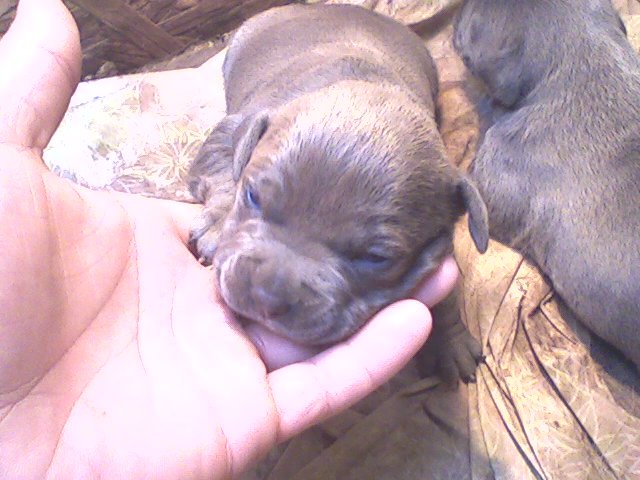 Puppy help? does this look like a nice quality puppy?
Question
3 weeks old
im getting this blue nose puppy so
Puppy help? does this look like a nice quality puppy?
Question
3 weeks old
im getting this blue nose puppy so
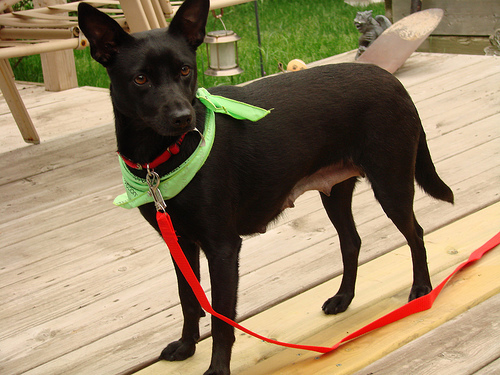 Guessing my dogs mix
Question
matilda
I was wondering if you could help what
Guessing my dogs mix
Question
matilda
I was wondering if you could help what
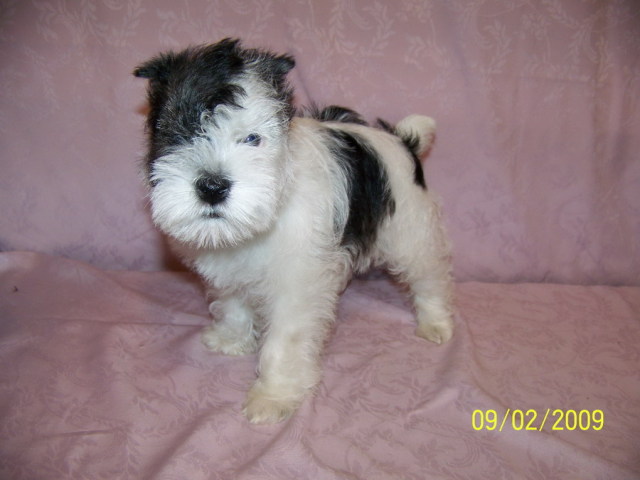 Eye problems w/ schnauzers
Question
Mini parti schnauzer
We currently have a 14 yr
Eye problems w/ schnauzers
Question
Mini parti schnauzer
We currently have a 14 yr
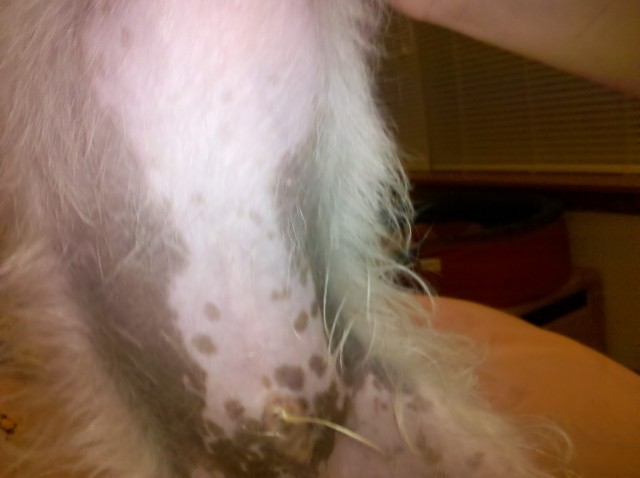 Maltipoo skin color
Question
Cooper
Hello, our family recently found
Maltipoo skin color
Question
Cooper
Hello, our family recently found
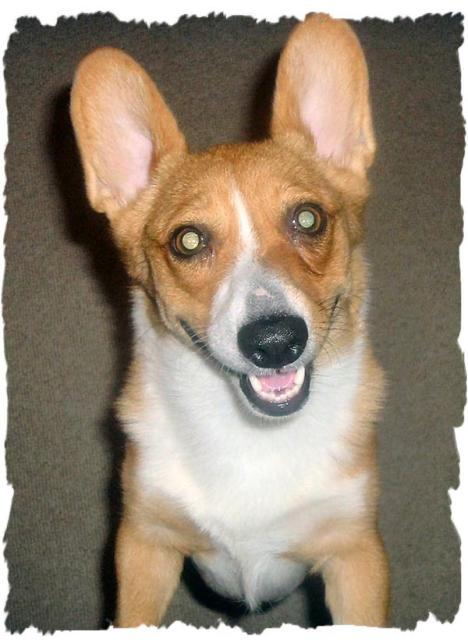 my 3 year old welsh corgi
Question
Bella
I have 2 old cairn terriers, 12 and 15 (
my 3 year old welsh corgi
Question
Bella
I have 2 old cairn terriers, 12 and 15 (